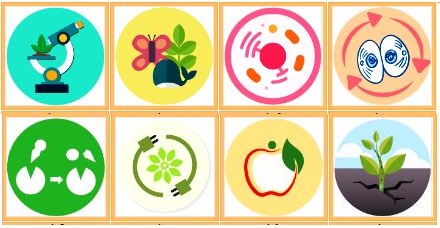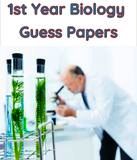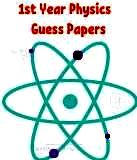1st Year Biology Guess Papers include short questions and extended questions, it is very necessary and students will be able to prepare for their exam through guess paper 1st-year biology all Punjab board 2022. Students can get 100% results through smart work. The marks of the Fsc (HSSC exam) are necessary for a student’s future.1st Year Notes for All Subjects are also available. Preparation according to the paper Pattern is also a must. Download 1st Year Pairing Scheme of All Subjects.
FSC 1st Year Biology Guess Paper 2023
(Important Questions)

UNIT-1 Important Short Questions
- Branches of biology
- Significance of the study of fossils
- Differentiate between inductive and deductive reasoning
- Compare Theory and Law
- How and when does a hypothesis become a theory
- Define the following:- biological control, IDM, hypertonic culture technique, pasteurization, bioremediation, endangered species, vaccination, productive theory, hypothesis
- Define population and write its effect
Long Questions
- Explain the biological method to solve a biological problem
- Given the advancement of biology in the production of food
- Describe the protection and prevention of the environment
- What is the role of the study of Biology in the welfare of Mankind
UNIT-2 Important Short Question
- Define biochemistry. Give its importance.
- Differentiate in catabolism and anabolism.
- Give the chemical composition of the bacterial and mammalian cells.
- Write any two productive functions of water.
- Define heat capacity and heat of vaporization for example.
- Define carbohydrates and give their general formula,
- Compare nucleotide and nucleoside.
- Compare Purines and Pyrimidines.
- What is fat considered a high-energy Molecule?
- What is the general formula of amino acids?
- What is the percentage of water in the brain cells of man?
Long Questions
- Write a note on the importance of water.
- Explain the structure of the protein.
- Write a short note on the amino acid.
UNIT-3 Important Short Question
- Define enzymes (Biocatalysts)
- Define active sites and write their two parts.
- Define cofactor and activator.
- Differentiate between prosthetic group and coenzyme.
- Differentiate between Apoenzymes and Holoenzymes.
- What do you mean by the Lock and Key model of enzymes?
- What is the induced fit model?
- What is an inhibitor and write its types?
- Compare competitive and non-competitive inhibitors.
- How does an enzyme accelerate metabolic reaction?
- What is activation energy?
UNIT-4 Important Short Question
- What are cell fractionation techniques?
- What is the chemical composition of the cell membrane?
- What are unit membrane models and fluid mosaic models?
- Compare primary and secondary wall
- Write the function of the cytoplasm.
- Compare cristae and cisternae.
- What are polysomes, murein, autophagosomes, and storage disease?
- The function of vacuole and nucleus.
- Is there any similarity between bacterial and plant cell walls?
- Compare chromatin and chromosomes.
Long Question
- Describe the function of the plasma membrane.
- Write a note on the cell wall.
- Describe the function of E.R.
- Define the structure and function of mitochondria.
- Write a note on plastid
- Differentiate between prokaryotic and eukaryotic cells.
- Compare the structure and function of chloroplast and mitochondria.
UNIT-5 Important Short Question
- Define species.
- Define binomial nomenclature. Who introduce it?
- Write down the classification of corn.
- What are Prions and viruses?
- What is capsid?
- Write the name of any four viral diseases.
- What are obligate parasites?
1st Year Biology Guess Papers Long Question
- Describe the life cycle of Bacteriophage.
- Draw the infection cycle of HIV.
- Write a note on Hepatitis
UNIT-6 Important Short Question
- What are streptococcus, staphylococcus, and tetrad?
- Classification of bacteria on the basis of Hagella?
- What are pills and write their functions?
- Compare cell walls of gram-positive and gram-negative bacteria.
Long Question
- Describe the nutrition of bacteria.
- Classification of bacteria on the basis of respiration.
- Explain different phases of growth in bacteria.
- Describe different chemical and physical methods to control bacteria.
- Write a note on the use and misuse of antibiotics.
UNIT-7 Important Short Question
- Kingdom protest is defined as exclusion. How?
- What is meant by a polyphyletic group of organisms?
- What do you mean by Giant amoeba?
- Write two characters of Zooflagelates.
- What is Trypanosoma?
- Compare pseudopodia with cilia.
- What is conjugation?
- Differentiate between choanoflagellates and trichonymphous.
- Differentiate between micronucleus and macronucleus.
- What is Coenocytes and thallus?
- What are diatoms, give their importance
- What are kelps?
- Write four characters of green algae similar to plants.
- What is Chlorella?
- Write the importance of algae.
- Write similarities and differences between fungus-like protists and fungi?
- Write two characteristics of Oomycetes and slim molds.
UNIT-8 Important Short Question
- What is nuclear mitosis?
- Define hyphae and write their types.
- What is Mycelium?
- What are mycorrhizae?
- What are haustoria?
- What are carnivorous fungi? Give example.
- What are dikaryotic hyphae?
- What are karyogamy and plasmogamy?
- Compare rust and smut.
- What are histoplasmosis and aspergillosis?
LONG QUESTION
- Describe the taxonomic status of fungi.
- Describe nutrition in fungi.
- Describe the general characteristics of fungi.
- Explain sexual and asexual reproduction in fungi.
- Describe ecological gain and loss due to fungi.
UNIT-9 Important Short Question
- Define bryophytes and why they are said to be amphibious plants.
- Define the term heteromorphic.
- What are gymnosperms? Also, give an example.
- Define double fertilization.
- Compare monocot and dicot.
- Compare megaspore and Microspore.
- What is heterospory?
LONG QUESTION
- Write a note on the adaptation of bryophytes on land habitats.
- Write a short note on the evaluation of the leaf.
- Describe the evaluation of seed habitats.
UNIT-10 important Short Question
- What are Diploblastics, triploblastic, Acoelomate, Coelomate, Psuedocoelomate, Gemmules, Hermaphrodite, and protandrous?
- Compare ostia and Osculum.
- Write the importance of spongs.
- What are nematocysts?
- What is enteron?
- Compare Polyps and medusa.
- What is polymorphism?
- What are coral reefs?
- What are flame cells?
- What is metamorphosis?
- Define nymph/Instar.
- What is redula?
- What is haemocyanin?
- Define regeneration?
- Differentiate between Radial and Bilateral symmetry.
UNIT-11 Important Short Questions
- Define the following:- bioenergetics, photosynthesis, compensation point, bacteriochlorophylls, chemiosmosis, Accessory pigment. Respiration, types of fermentation.
- Write molecular formula of chlorophyll a and chlorophyll b.
- What are antenna complex?
- Compare photo system-I and photo system-II.
- What is cellular respiration? Write its stages.
- What is net production of ATP during Glycolsis?
- Difference in phosphorylation and oxidative phosphorylation.
- How is the formation of Vitamin A linked with eating of carrot?
LONG QUESTION
- DESCRIBE Van Neil Hypothesis.
- Write a note on Non-cyclic phosphorylation.
- Write a note on cyclic phosphorylation.
- Draw and explain Kalvin cycle.
- Explain Glycolysis.
- Explain Kerb’s Cycle.
- Write a note on Respiratory chain.
- Compare photosynthesis and respiration in plant.
UNIT-12 Important SHORT QUESTIONS
- Define symbiotic association with an example.
- Give the function of the oral cavity.
- What is the composition of gastric juice?
- What is hunger pang?
- Define peristalsis and anti-peristalsis.
- Write names and functions of enzymes secreted by the pancreas.
- The function of Gastrin and secretion.
- Differentiate in diarrhea and constipation.
- What is common food poisoning?
- What is botulism?
- Write symptoms and causes of dyspepsia.
- How can we control obesity?
LONG QUESTION
- Describe Heterotrophic Nutrition in Plants.
- Write a note on digestion in the oral cavity in man.
- Describe digestion in food in the stomach.
- Describe the digestion of food in the small intestine.
- Define nutrition. Describe the role of different elements in plants nutrition.
UNIT-13 important SHORT QUESTIONS
- Advantages and disadvantages of gas exchange in air and water.
- Compare stomata with lenticels.
- Write properties of respiratory surface in animals.
- Function of nasal cavity.
- What is diaphragm and pleura?
- Compare inspiration and expiration.
- What are alveoli?
- Compare oxyhaemoglobine and carboxy haemoglobine.
- What is CO2 concentration in arterial and venous blood?
- Differentiate haeomoglobin andand myoglobine.
- Write a note on cancer, T.B, asthma.
- Write composition of inhaled and exhaled air.
- What is diving reflex?
- How does breathing differ from respiration?
UNIT-14 important SHORT QUESTIONS
- Describe processes involved in the absorption by roots in uptake of minerals.
- Define transpiration.
- Define Imbibtion, and bleeding in plants, source, sink, pressure flow theory.
- Write function of protein present in plasma?
- Write function of platelets.
- Compare bicusbid and tricusbid valves.
- What are blue babies?
- What ECG?
- What is the function of artificial pacemaker?
- What is hypertension, myocardial infaraction, systolic and diastolic pressure?
- Compare thrombus, embolus.
- Differentiate in blood and lymph.
- What is cell mediate response?
- What is antiserum?
LONG QUESTION
- Write a note on Ascent of Sap.
- Describe different hypothesis for opening and closing of stomata.
- Comparison of open and closed circulatory system.
- Write down function of blood.
- Explain Leucamia and thalassemia.
- Write a note on W.B.Cs.
- Describe structure and function of human heart.
- Compare structure. Function of artries, vein and capillary.
- Define lymphatic system. Give its function.
- Define immunity. Give its major types.



